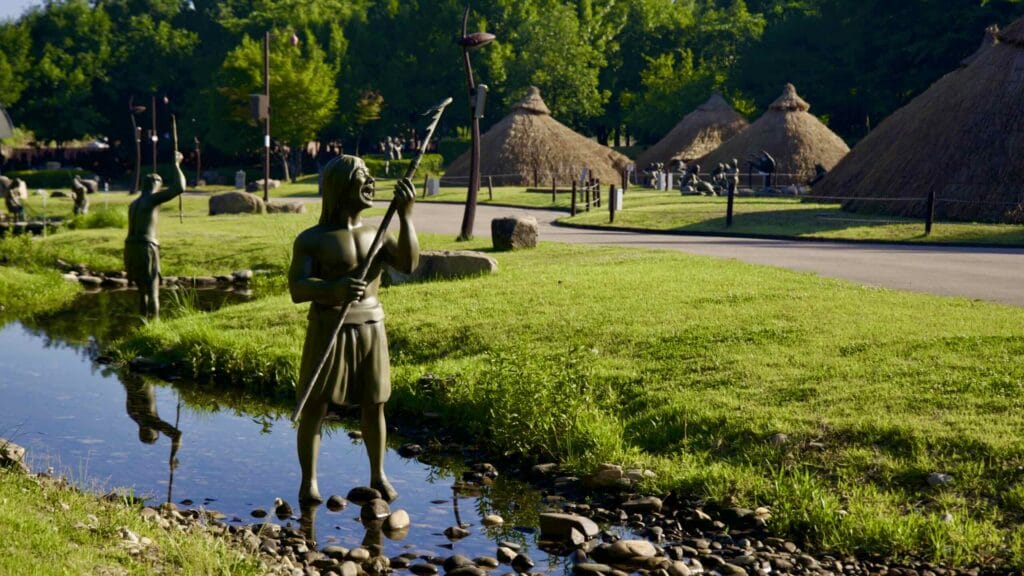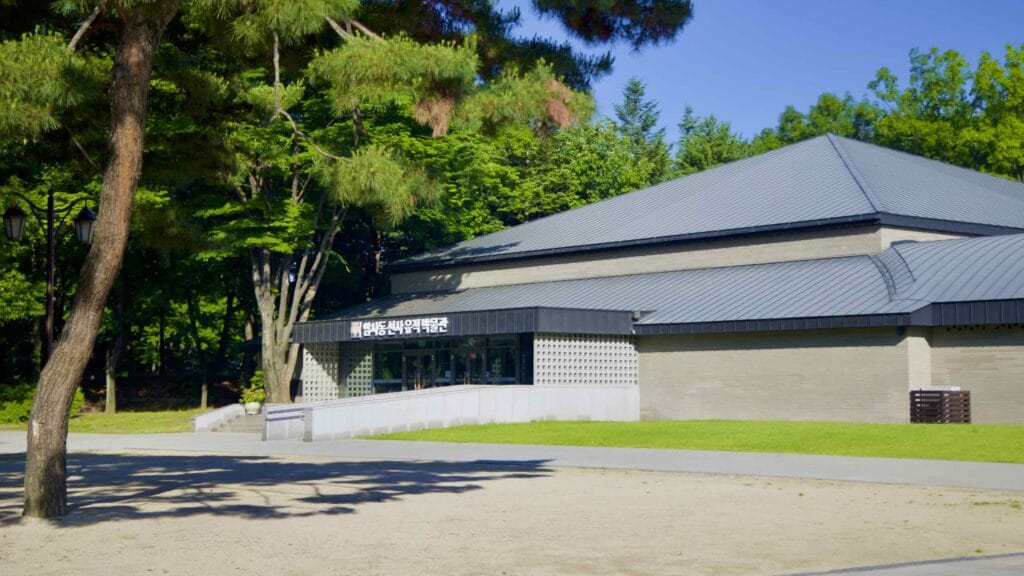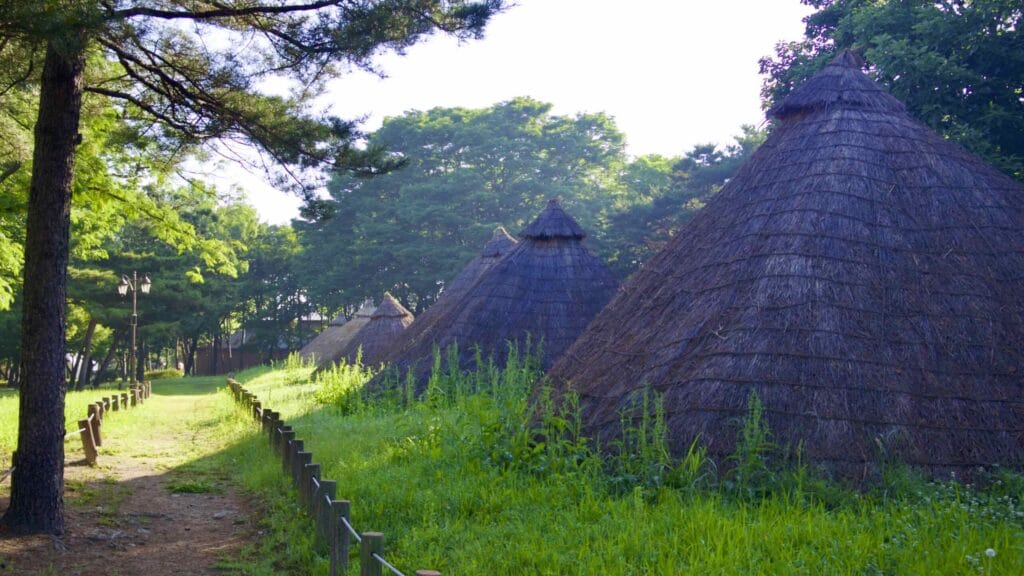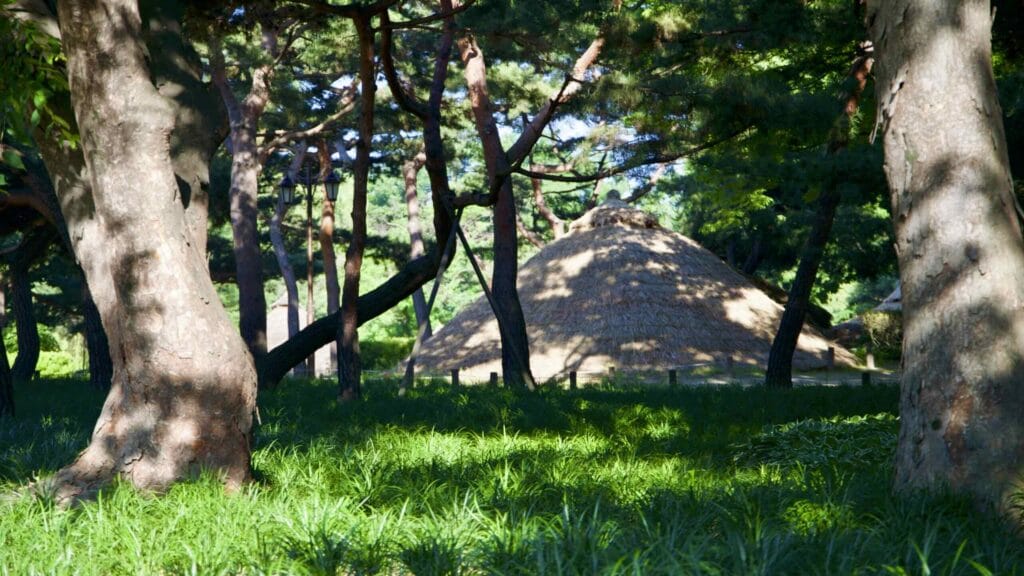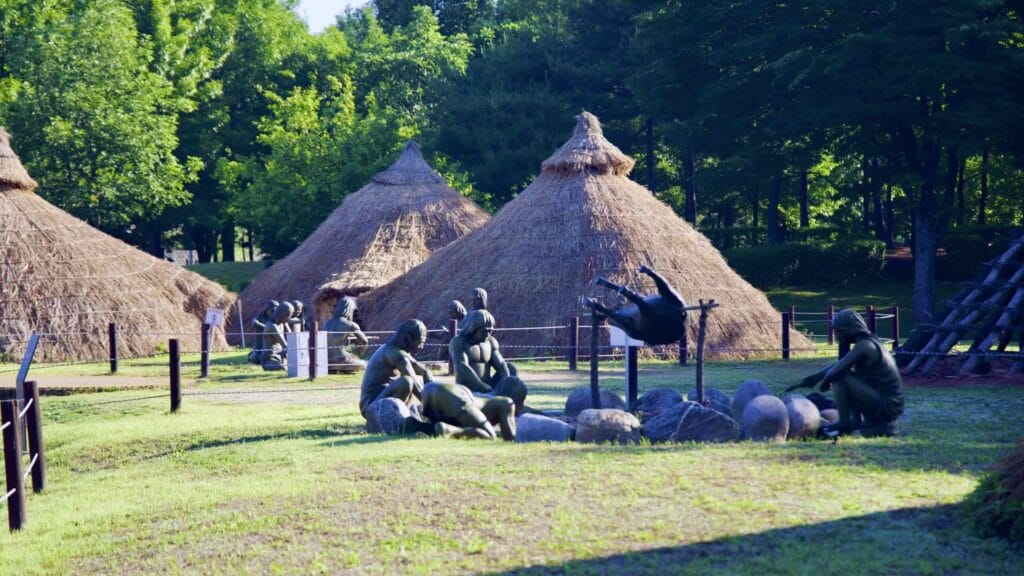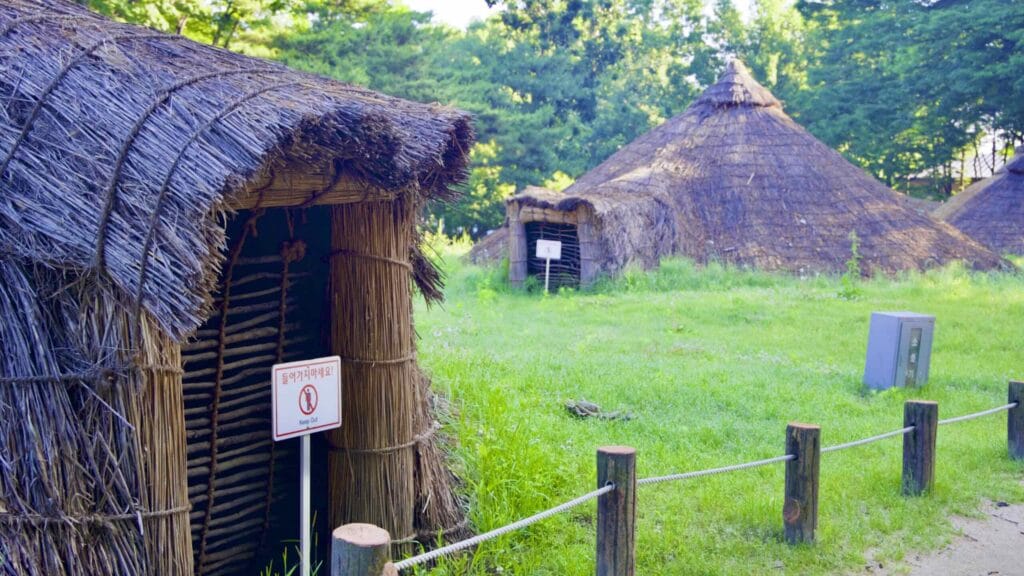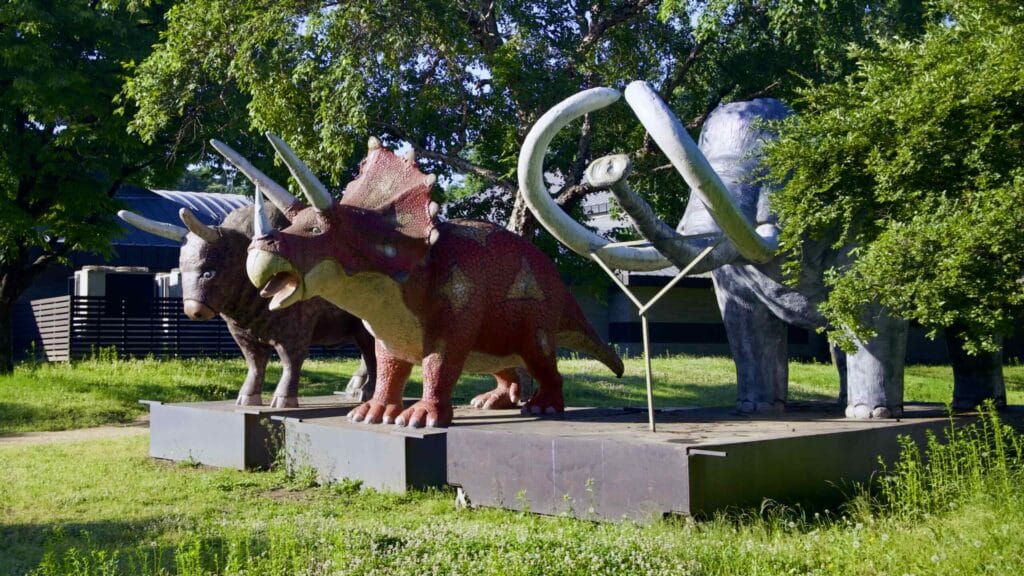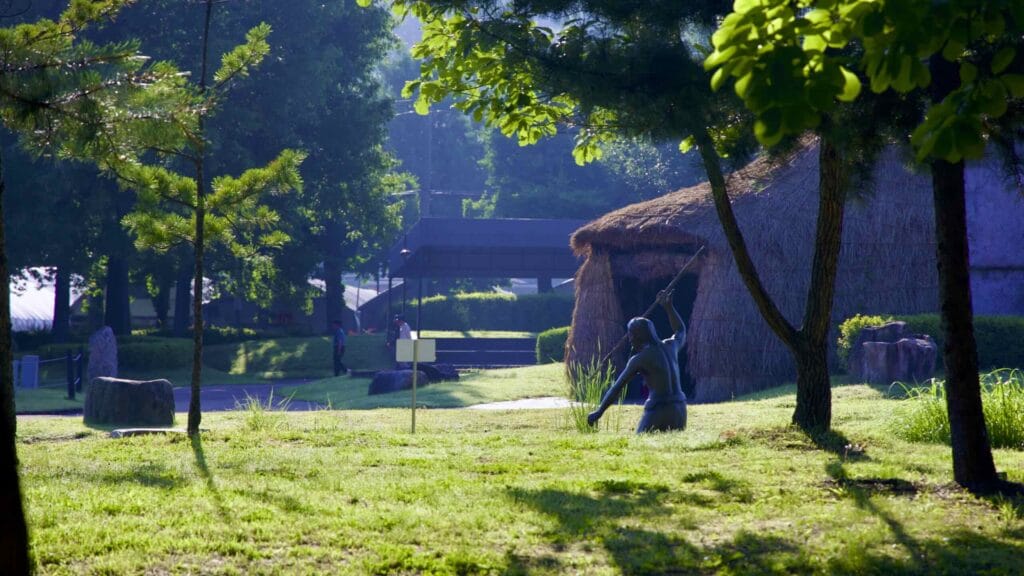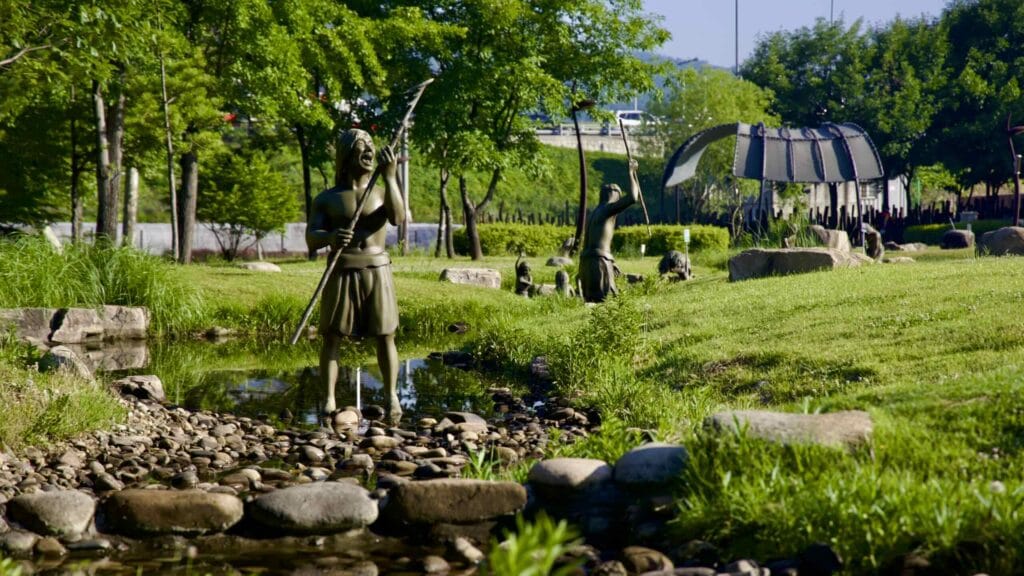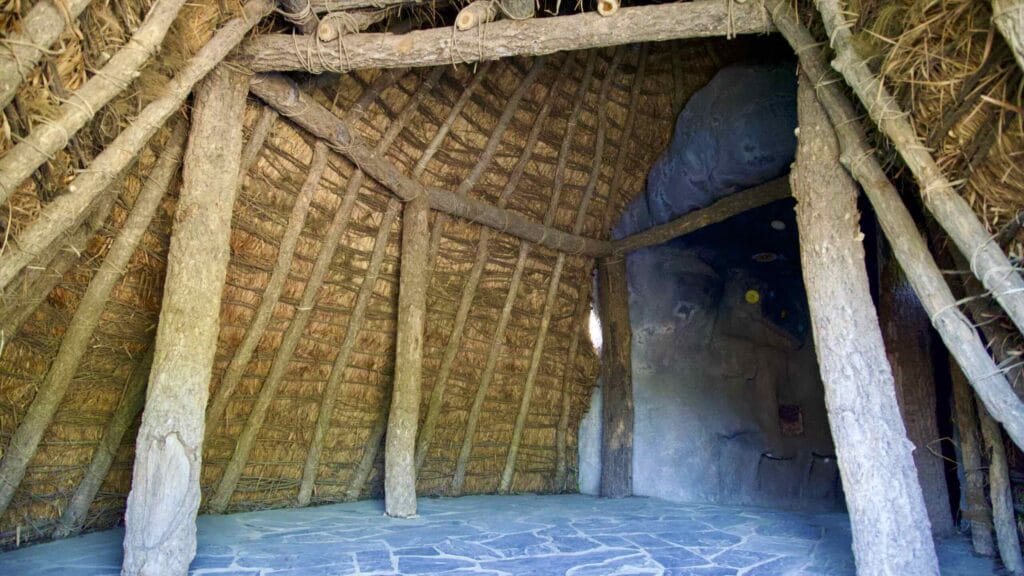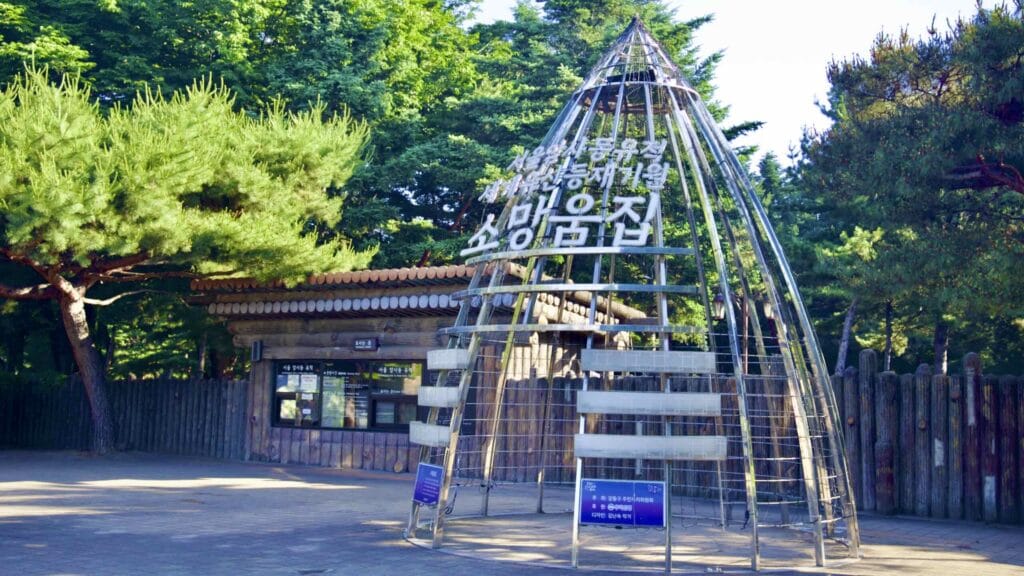Amsa Prehistoric Site
Amsa Prehistoric Site (암사선사주거지; map) is a preserved Neolithic excavation site and museum along the Han River in Seoul’s eastern Gangdong District (강동구; map).
First, let’s explore how the site formed, then learn about it today.
A River Wild
The Han River has a wild past. Before the 20th century, rain and upriver snowmelt created extreme changes in the river’s flow. Sudden influxes of water shifted the river’s silty underbelly, flooding some areas, drying out others.
Gangdong took the brunt of the impact. Fast floods often breached the district’s flat riverside regions, washing away waterside neighborhoods like Pungnap (풍납동; map). Until the 1980s, during the monsoon season, Pungnap residents often made their commutes via DIY rafts.
The Great Flood
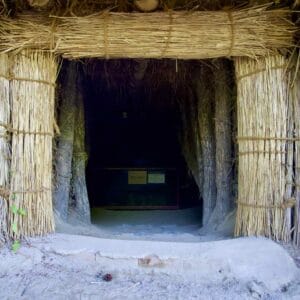 In 1925, a typhoon converged with monsoon rains and dumped yearly-amounts of water into the Han River, creating two to back-to-back floods that swept away every riverside thing in Seoul.
In 1925, a typhoon converged with monsoon rains and dumped yearly-amounts of water into the Han River, creating two to back-to-back floods that swept away every riverside thing in Seoul.
The flood killed hundreds and reshaped the Han River’s path. But it also revealed bits of ancient pottery in the Amsa Neighborhood (암사동; map). Once the waters receded, scientists poked around the site and guesstimated the pottery held an untold history.
However, Korea couldn’t perform a proper excavation. Japanese Occupation, WWII, and the Korean War stole resources and time away from Korea’s scientific endeavors for decades.
Amsa Prehistoric Site
Archaeologists finally got their chisels and brushes on the Amsa site in 1957 and found an extraordinary wealth of history.
The site contained three layers:
- The top layer held jars, tombs, and axes from the Kingdom of Baekje (백제; 18 BCE ~ 660 CE), one of the first kingdoms that settled the Han River basin.
- One layer below, scientists found earthenware, arrowheads, and weaving tools (가락바퀴) from the Bronze Age (3300 ~ 1200 BCE).
- And the bottom layer held 6,000-year-old comb pattern pottery.
Six thousand years old?
Yep. From the Neolithic Period (Stone Age). Older than the Pyramids of Giza (2600 BCE).
Further excavations of the site found remnants of some of the earliest permanent human settlements along the Han River, including:
- A network of thirty pits dug into the soil where thatch huts once stood.
- A rock furnace in the middle of the settlement with traces of burnt charcoal.
- Earthenware pottery, grinding stones, spears, stone axes, and arrowheads.
Museum and Exhibition Space
After scientists finished extracting and preserving artifacts, the Gangdong turned the site into a learning center and tourist attraction.
The ancient pits where thatched huts once stood now sit inside a museum, along with tools and pottery found on the site.
Outside the museum rests a full-scale replica of Amsa’s Neolithic village, which radiates around a communal furnace used to cook and make pottery. Statues of Neolithic families sit around thatched huts cooking, fishing, crafting.
Amsa Prehistoric Site
Amsa Prehistoric Site (암사선사주거지; map) is a Neolithic excavation site and museum near the Han River in Seoul’s eastern Gangdong District (강동구; map).
First, let’s explore how the site formed, then learn about it today.
A River Wild
The Han River has a wild past. Before the 20th century, rain and upriver snowmelt created extreme changes in the river’s flow. Sudden influxes of water shifted the river’s silty underbelly, flooding some areas, drying out others.
Gangdong took the brunt of the impact. Fast floods often breached the district’s flat riverside regions, washing away waterside neighborhoods like Pungnap (풍납동; map). Until the 1980s, during the monsoon season, Pungnap residents often made their commutes via DIY rafts.
The Great Flood
In 1925, a typhoon converged with monsoon rains and dumped yearly-amounts of water into the Han River, creating two to back-to-back floods that swept away every riverside thing in Seoul.
The flood killed hundreds and reshaped the Han River’s path. But it also revealed bits of ancient pottery in the Amsa Neighborhood (암사동; map). Once the waters receded, scientists poked around the site and guesstimated the pottery held an untold history.
However, Korea couldn’t perform a proper excavation. Japanese Occupation, WWII, and the Korean War stole resources and time away from Korea’s scientific endeavors for decades.
Amsa Prehistoric Site
Archaeologists finally got their chisels and brushes on the Amsa site in 1957 and found an extraordinary wealth of history.
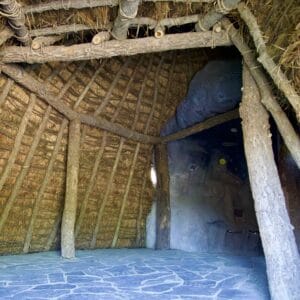
The site contained three layers:
- The top layer held jars, tombs, and axes from the Kingdom of Baekje (백제; 18 BCE ~ 660 CE), one of the first kingdoms that settled the Han River basin.
- One layer below, scientists found earthenware, arrowheads, and weaving tools (가락바퀴) from the Bronze Age (3300 ~ 1200 BCE).
- And the bottom layer held 6,000-year-old comb pattern pottery.
Six thousand years old?
Yep. From the Neolithic Period (Stone Age). Older than the Pyramids of Giza (2600 BCE).
Further excavations of the site found remnants of some of the earliest permanent human settlements along the Han River, including:
- A network of thirty pits dug into the soil where thatch huts once stood.
- A rock furnace in the middle of the settlement with traces of burnt charcoal.
- Earthenware pottery, grinding stones, spears, stone axes, and arrowheads.
Museum and Exhibition Space
After scientists finished extracting and preserving artifacts, the Gangdong turned the site into a learning center and tourist attraction.
The ancient pits where thatched huts once stood now sit inside a museum, along with tools and pottery found on the site.
Outside the museum rests a full-scale replica of Amsa’s Neolithic village, which radiates around a communal furnace used to cook and make pottery. Statues of Neolithic families sit around thatched huts cooking, fishing, crafting.
- 1. World Cup Park
- 2. Seoul Battleship Park
- 3. Seonyu Island Park
- 4. Yeouido
- 5. Hangang Art Park
- 6. Hangang Railway Bridges
- 7. Nodeul Island
- 8. Banpo Grand Fountain Bridge
- 9. Some Sevit
- 10. Namsan Mountain & Tower
- 11. Seoul Forest
- 12. Seongsu Neighborhood
- 13. J-Bug Cultural Complex
- 14. Apgujeong Rabbit Cave
- 15. Gangnam District
- 16. Jamsil Sports Complex
- 17. The World of Lotte
- 18. Olympic Park
- 19. Amsa Prehistoric Site
- 20. Hanam & Guri Towers
- 21. Neungnae Station
- 22. Bukhangang Railroad Bridge
- 23. Yangpyeong Dumulmeori
- 24. Yangpyeong Tunnel Hopping
- 25. Ipo Weir
- 26. Yeoju Weir
- 27. Tomb of King Sejong
- 28. Gangcheon Weir
- 29. South Han River Islands
- 30. Jungangtap Park


